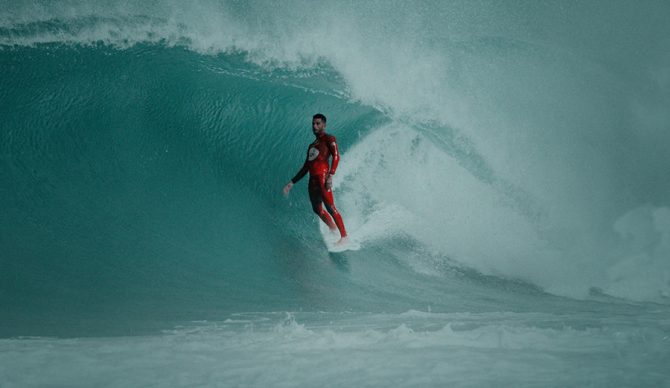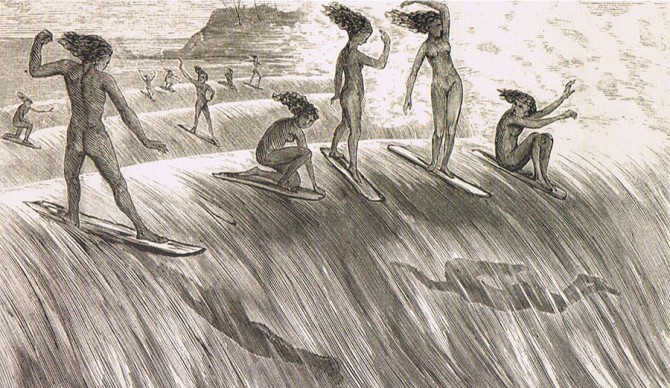
Filipe Toledo has made surfing in a jersey look very, very good. Photo: WSL
Editor’s Note:Welcome to Surf History 101, where we look at innovations in the world of surfing and beyond that changed the pursuit forever. In this edition, Sam George examines the surf contest and its impact on our culture.
What Is It?
An organized competitive format in which participants are judged, most often subjectively, on their respective surfing skills.
Who Developed It?
There’s little doubt that competitive surfing can trace its roots to the Hawaiian Islands, perhaps as early as the 12th century. It would seem that soon after the sport began to flourish in the more accommodating waves to be found throughout the archipelago, Island surfers began wanting to prove who was more adept at riding them. These events, however, hardly resembled the surf contests of today. As revealed in historian John R.K. Clark’s exhaustively researched Hawaiian Surfing: Traditions from the Past, competitive wave riding in old Hawaii fell under the category of “heihei”, meaning “a race.” Clark refers to this description of the ancient format from a 1951 volume called Hawaiian Antiquities:
“When the bets were all put up, the surf riders, taking their boards with them, swam out through the surf till they had reached the waters outside the surf. The surf riders having reached the belt of water outside the surf, the region where the rollers began to make head, awaited the incoming of a wave, in preparation for which they got their boards underway by paddling with their hands, until such time as the swelling wave began to lift and urge them forward. Then they speeded to the shore until they came opposite to where was moored a buoy which was called a ‘pua’. If the combatants passed the line of this buoy together, it was a dead heat; but if one went by it in advance of the other, he was the victor.”
In surf races of this sort, “combatant” is apparently the appropriate term. A 19th century account describes a tough heat in which the surfer Pai’ea dropped in on another named Umi, forcing his competitor into the rocks and injuring his arm. Although Umi went on to win the “race,” when later he became king of the island of Hawaii he had Pai’ea put to death in surf history’s first — and most consequential — interference call. (Ka Kupepa Kuakoa, 1862.)
These sorts of simple, objective “surf races” might seem quaint by today’s standards, but in historical terms they haven’t sunk that far beyond the horizon. Beginning in 1928 and running until 1941, the Pacific Coast Surf Riding Championships maintained a format that had surfers paddle racing out to the lineup, then turning and riding back to shore, the first board to touch the sand being declared the winner.
As late as 1952, when the Waikiki Surf Club held the first Makaha International Championships, and lasting well into the mid-1960s, the event’s judging criteria included elements of the antiquated surf race, with competitors primarily being scored on length of ride, ascertained by a system of buoys set throughout the lineup. Skill and sportsmanship were ranked further down the page. Since that time competitive surfing has moved away from any objective formats, slowly evolving into a completely subjective realm whose vagaries would surely seem incomprehensible to our Polynesian forbearers. One thing we can be sure about, however, is that like so many other aspects of modern surf culture, we have Hawaii to thank for competitive surfing.

The surfer’s whose board was first to touch the sand was crowned the winner. It doesn’t get much more objective.
What It’s Meant to Surfing
With the exception, perhaps, of wearing Ugg Boots on the beach, there has been no more polarizing aspect of modern surf culture than surf contests. Oddly enough, the root of this division stems from a barefoot version of a philosophical theory known as “existentialism,” defined as “…the belief that society [in our case competitive sanctioning bodies] should not restrict an individual’s life or actions and that these restrictions inhibit free will and the development of that person’s potential.”
Let’s put it another way, with the help of a story once told by the late, great Rabbit Kekai, who, having competed in surf contests over a five-decade span, had perhaps the longest competitive career in surf history. But he recounted a story passed down to him him by an older Waikiki beach boy, telling of how at a meeting proceeding one of those early century surf races, someone suggested, “Hey, along with the buoy race, why don’t we also judge how well the surfer rides his wave back to shore?” The assembled watermen pondered this idea for a moment, but then collectively shook their heads in the negative. “That’s ridiculous,” came the general consensus. “Everybody rides differently, in their own personal style. How could you possibly judge it?” The idea was summarily tabled, like, “Yeah, I guess that’s a pretty dumb idea.”
Yet this idea of subjectively judging surfing has prevailed in the decades since, in many and various incarnations, creating a rift that runs right down the center of the sport. Well, maybe not quite the center, the surfers who feel that surf contests are dumb most probably outnumbering those who don’t by a considerable margin. This gap exists because, despite the Pacific Coast Surf Riding Championship, the Waikiki Surf Club, the USSA, WSA, HSA, ESA, IPS, NSSA, PSAA, ASP and WSL’s best efforts to establish surfing as a legitimate sport, the majority of its devotees consider it to be something very different. Something less definable, less-regimented, more of an individual expression than a quantifiable performance. As such, its fan base is relatively small in comparison to the total number of participants. So different from traditional professional sports like football, baseball and basketball, whose actual participants are dwarfed by the number of fans to the tenth power.
So what have all these years of surf contest meant to surfing? Aside from the creation of a viable surf industry marketing platform in the mid-1960s and then again beginning in the mid-1970s, and the advent of the twin fin, and subsequently the thruster, in the late-1970s, early 1980s, not a whole lot. From The Endless Summer to Kandui Island Resort, from toes-over to tow-in surfing, from aerials to Arctic Circle exploration, from Roxy Girls to removable fins, from Gidget to Justine Dupont, from WaveStorms to Nazare; when viewed objectively, it becomes clear that very few of surfing’s quantum leaps have been launched from a contest heat. Fun to watch, if you’re into that sort of thing, but that’s about it.
Why It’s Not Going Away
That’s easy: Kelly Slater, Stephanie Gilmore, John John Florence and Carissa Moore. World champion competitors, sure, but more importantly world-class examples of peak artistic surfing self-expression, soggy, wet jersey or not.
For a collection of longer reads by Sam George go to samgeorgeworld.substack.com

